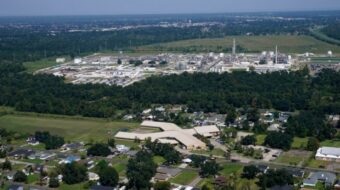
WASHINGTON (PAI)-The Teamsters, who represent 35,000 freight railroad track maintenance workers, are contending that increasing numbers of train derailments – including oil tank car derailments – occur because U.S. railroads refuse to spend enough money to maintain railroad tracks.
As a result, the union’s Brotherhood of Maintenance of Way Employees division says, freight trains loaded with oil derail and the tank cars burn and explode.
The issue of tank cars exploding and befouling the environment, hurting or killing people and causing evacuations of nearby communities is important. BMWE President Freddie Simpson, citing federal data, says freight trains derailed 1,220 times last year, causing at least $200 million in damage to tracks and rail beds alone, not counting other damage.
Lousy track conditions caused 39 percent of all derailments, he adds. The percentage was even higher (47 percent of 329 accidents) on main lines. And Simpson notes that U.S. railroads now transport 400,000 tank-car loads of oil yearly.
“Main line tracks crisscross the nation passing through thousands of cities, towns, and communities where we live,” said Simpson. “The key to reducing track-caused derailments is maintaining the tracks to a higher safety standard.
“Unfortunately, the railroads’ statistics speak for themselves: Track-caused derailments including those involving highly volatile crude oil continue to be a threat to the nation. We can significantly improve railroad safety by improving the quality of the track. The technology, the skilled workers, and the higher track standards already exist; this is not rocket science.
“Wear and tear on the track structure, coupled with the volatility of the commodities being transported, requires additional track maintenance to stay ahead of the rate of track degradation. The railroad companies have been amassing record profits for years and we want them to continue to be exceptionally profitable. Safety and profitability go hand-in-hand.”
But Christopher Hart, chairman of the National Transportation Safety Board, which investigates accidents and publishes recommendations to prevent future disasters, adds another cause for the oil tank car fires and explosions: The tank cars themselves.
In so many words, NTSB told the federal agency that regulates transportation of hazardous materials, the tank cars are too thin-skinned to survive the heat when one catches on fire, and they don’t have thermal relief valves to reduce the pressure and lessen the possibility of subsequent fires and explosions
So when one oil tank car derails and catches fire, its heat increases pressure in the other cars, which in turn explode and produce fireballs – a chain reaction of exploding tank cars. NTSB recommended increasing the thickness of the steel on tank cars, so they could survive heat for 800 minutes, not 100, and installing thermal relief valves on all of them.
Photo: NTSB Rail Investigator inspects a recorder from a locomotive that was involved in a derailment. NTSB flickr.










